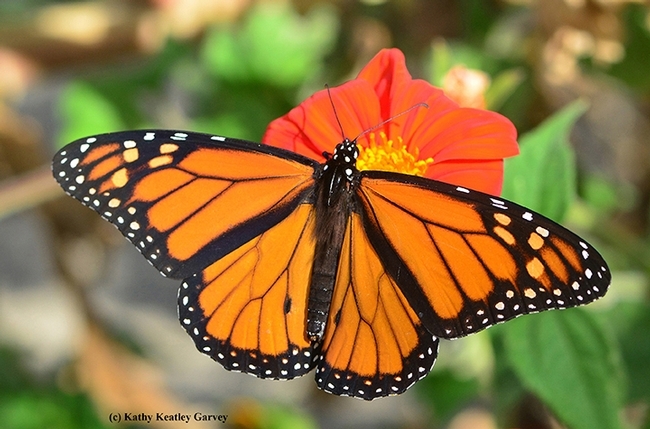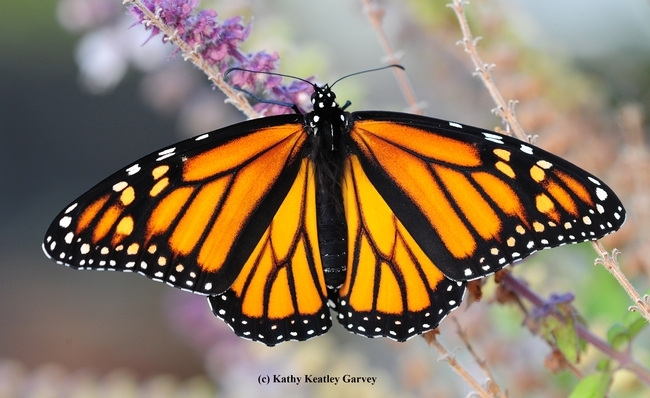- Author: Kathy Keatley Garvey

The article, “Complexity, Humility and Action: A Current Perspective on Monarchs in Western North America,” is “meant to provide a concise review of and perspective on recent western monarch research,” Yang said.
The western monarch population overwinters along the California coast. Estimated at 4.5 million in the 1980s, it has dropped significantly over the past five years, the professor related, noting an “86% single-year population decline in 2018, an overwintering population of less than 2000 butterflies in 2020, and an unexpected >100-fold increase in 2021."
Yang defined the western monarch population as occupying "a geographically distinct region of North America west of the Rocky Mountain...Ongoing climate change has made the western monarch range warmer, drier, and more prone to heatwaves, wildfires, and winter storms with complex effects on their ecology. Land development and changes in the structure of landscape mosaics have modified both the breeding and overwintering habitats of western monarch butterflies, changing the spatial distribution of resources and risks across their range. Shifts in agricultural and horticultural practice have changed the nature of potentially deleterious chemicals in the environment, including novel herbicides and insecticides."
Yang said the spread of non-native milkweed species has likely had both positive and negative consequences for western monarchs, and more research is needed.
His three suggestions:
- "First, we should continue to support both basic and applied monarch research. This includes efforts to better understand fundamental aspects of monarch biology, studies to examine the ecological factors that limit monarch populations in the West and efforts to improve more targeted adaptive management and monitoring efforts. Basic research in monarch biology and ecology improves our understanding of this complex system and can inform conservation actions in profound and unexpected ways. In turn, applied research can address recognized gaps in knowledge that would otherwise limit available strategies for conservation planning and management."
- "Second, recognizing the limits of our current understanding, we should follow the precautionary principle to minimize the risk of counterproductive action. The complexity of this system makes it difficult to anticipate or assume future changes in behavior, species interactions or population dynamics. In practice, this may mean prioritizing efforts to better understand and facilitate existing mechanisms of ecological resilience and recovery over direct actions to manipulate or augment the population with less certain consequences. More broadly, this approach would probably emphasize common sense approaches to mitigate the widely recognized upstream drivers of global change (e.g., climate change and land use change), rather than those requiring a detailed understanding of their complex, interactive effects on species-specific ecologies further downstream."
- "Third, we should work to improve, protect and maintain the resources required throughout the complex monarch life cycle. In part, this likely means prioritizing conservation efforts that target the times and places that are likely to have the greatest positive effects, building on the common ground of available science. In the case of western monarchs, this includes protecting current and future overwintering habitats, the resources required for population expansion in the early season, and the resources required for the fall migration. Recognizing the potentially widespread and pervasive effects of pesticides, this could also mean efforts to develop more ecologically realistic and relevant metrics for the regulation of environmental chemicals."
Yang opined that "In the broader context, many of the drivers that are contributing to western monarch population declines are likely to also be affecting other species. In turn, many of the strategies that would support monarch conservation would likely benefit other species, and many of the strategies that would benefit other species are likely to also support monarch conservation. As we build on currently available science to better understand and protect the western monarch population, it is imperative that we continue to grapple with the inherent complexity of this system and respond with appropriate humility and necessary action."
Among the 54 scientific publications that Yang referenced was a research article co-authored by UC Davis Distinguished Professor Art Shapiro, who has studied butterfly populations in Central California since 1972. The article, "Fewer Butterflies Seen by Community Scientists across the Warming and Drying Landscapes of the American West," published in Science in March 2021, covered data from the Shapiro transect, the North American Butterfly Association (NABA) community count data and the iNaturalist community observation data. The study observed widespread declines across 450 butterfly species, including the monarch butterfly, in the American West. The authors estimated a 1.6 percent decrease in overall butterfly abundance each year over a 42-year period from 1977 to 2018.
Editors of the journal, Current Opinion in Insect Science, describe it as "a new systematic review journal that aims to provide specialists with a unique and educational platform to keep up–to–date with the expanding volume of information published in the field of insect science."
Yang's research is supported by a National Science Foundation award. He was a guest on National Public Radio's Science Friday in February 2022. Listen to the interview here.




